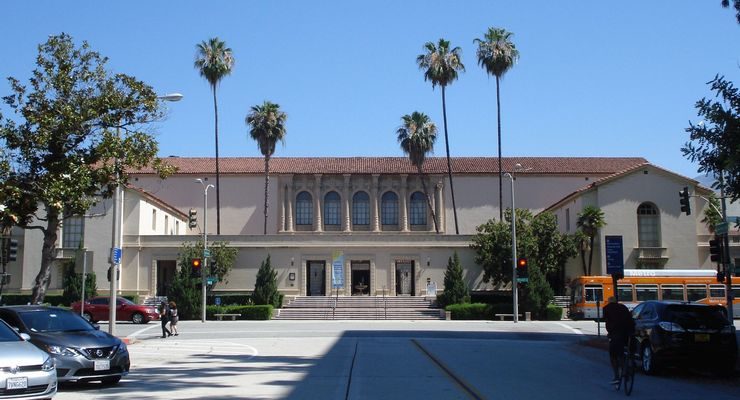
Metro via Instagram
A proposal for Metro to create its own police department has been approved by a 10-0 vote of its Board of Directors following public safety concerns and months of highly publicized violent crimes on its system, and Friday there is five-year plan to put it in place.
The Transit Community Public Safety Department will be rolled out over the course of five years. Metro’s current contracts with its three law enforcement agencies — Los Angeles County Sheriff’s Department, Los Angeles Police Department and Long Beach Police Department — will remain in place until then, according to Robert Gummer, the agency’s interim deputy chief of system security and law enforcement.
“So having greater control and accountability over law enforcement, centering on community safety and care-based strategies, and addressing the unique quality of life challenges on trains and buses — this is why I’m supporting us moving forward with a new model,” Board Chair and Los Angeles Mayor Karen Bass said prior to the vote, who joined the meeting remotely
“Again, a new model that will take years to implement.”
Bass said she has felt strongly that law enforcement agencies were essentially “dumped” with the social, health and economic problems that governmental agencies have not supported. She added that Metro has an opportunity to create a department that can respond aggressively in a traditional manner similar to that of law enforcement, but also not burden law enforcement with social service needs.
The Board of Directors discussed four deployment models, outlining options to improve visibility of officers on bus and rail systems. Metro leaders chose to move forward with what was described as the “Enhanced Service Model.”
This model will build upon what the agency currently has — retaining 386 officers — but adding more ambassadors, crisis interventionists, clinicians and homeless outreach providers. The goal is for the in-house department to have 673 staff working in public safety, an increase of about 227 from the current figure.
According to Metro officials, the plan is estimated to cost $192.6 million per year compared to the $194 million multi-agency contract. The agency is expected to implement a “Zone-Based Deployment,” creating five areas which will be overseen by the in-house public safety.
“You will have the ability to impart the values and expectations on all levels of the organization,” Gummer told City News Service. “We will also be able to ensure a continuous and engaged law enforcement presence.”
Gummer explained — through this in-house public safety department — will be able to tactically assign resources to protect Metro’s bus and rail by having more foot patrols and officers riding the system. The agency will have a “zone-deployment model,” breaking up the system across the county into five areas, which officials say will give them the ability to meet the specific needs of those areas.
Metro staff explained that the multi-agency contract has had its challenges, such as the lack of alignment with Metro policies, procedures and safety approaches; a lack of power over how law enforcement personnel are deployed and their methods; and what officials described as a “continuous and unsustainable cost escalation.”
Staff noted that each year the contract with law enforcement agencies has grown 10% to 15% annually.
County Sheriff Robert Luna, Los Angeles Police Department interim Chief Dominic Choi and Long Beach Police Department Chief Wally Hebeish — who attended the directors’ meeting — pushed back against the proposal and exchanged, at times, tense words with members of the board.
“…We have the same mission to keep our ridership safe and that is the number one priority, but we’re responsible for meeting the terms of our contract, which I believe all of us are doing,” Luna said.
“I am concerned about the report that we just talked about — that may be inaccurate and potentially misleading. I’m very concerned that the decisions being made are being made without the consultation of the current contracted law enforcement executives.”
In response to concerns over deployment and law enforcement agencies being non-compliant with Metro’s policies, Luna said they would willingly have more open conversations and address any issues with the other two chiefs agreeing.
“None of us have come up here before you in several years. I think that’s unacceptable. You need to hear from us,” Luna said.
Luna also said Metro may face a challenge in hiring — noting it takes about three years to get a police officer from recruiting, training and sworn-in. Gummer told City News Service the agency feels that they will be able to recruit and hire potential candidates because the mission will be focused on protecting riders and ensuring the safety of the system.
“As the county sheriff responsible for public safety in this county, I have to make sure that with the World Cup coming in, the Olympics and the (2027) Super Bowl — this is not a time to experiment with new projects,” Luna said. “Public safety is too critical to do that with.”
The law enforcement executives explained why the contractual costs have increased over the years, pointing to growth the Metro system has experienced. Choi noted that the department bills the agency about $188 to $189 per hour because 70% of the system is within their jurisdiction.
Luna noted that whether the agency moved forward with its plan for an in-house department that all three law enforcement executives would collaborate with Metro.
“It’s kind of like a divorce where you still love each other but certain things have gotten in the way,” Director and Glendale City Councilman Ara J. Najarian. “Sometimes things just don’t work out. I don’t think we are ever going to envision a system where we don’t have any contact with our law enforcement partners.”














 3 comments
3 comments


